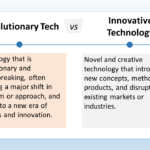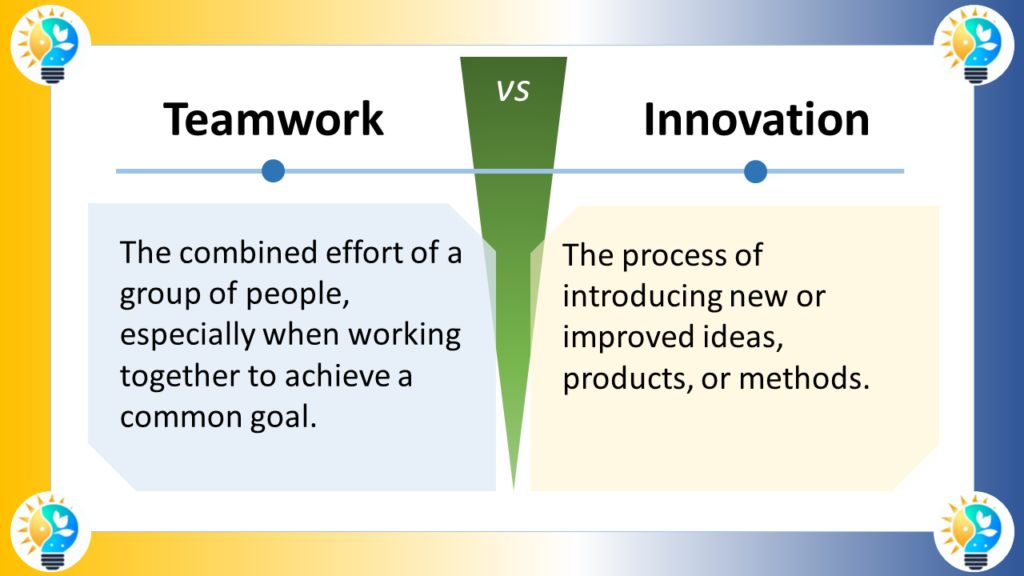Revolutionary tech and innovative technology drive progress, but while revolutionary tech implies a major paradigm shift, innovative technology actively introduces new concepts or products to catalyze innovation.

In the dynamic landscape of technology, the difference between Innovative Technology and Revolutionary Tech is significant, with each term carrying its own weight and implications in the context of technological progress.
Definition
Defining Innovative Technology
Innovative Technology is about bringing new ideas to life or significantly improving existing technologies. It is the bread and butter of the tech world, driving continuous change and keeping industries competitive.
Characteristics of Innovative Technology
- Incremental or Radical: Can be small-scale improvements or substantial changes.
- Problem-Solving: Often developed in response to a particular need or challenge.
- Market Influence: May create new opportunities or enhance user experiences.
Defining Revolutionary Tech
Revolutionary Tech, however, is transformative by nature. It denotes a groundbreaking shift that changes the way entire systems or societies operate, often becoming the benchmark for future developments.
Characteristics of Revolutionary Tech
- Disruptive: Has the potential to disrupt markets or displace existing technologies.
- Paradigm-Shifting: Alters the foundational approach to problems or tasks.
- Long-term Impact: Leads to a lasting change in behavior, industry standards, or societal functions.
Exploring a Variety of Synonyms for Innovative Technology
- Advanced Technology
- Cutting-Edge Innovations
- Cutting-Edge Breakthroughs
- Disruptive Tech
- Emerging Technologies
- Forward-Looking Tech
- Futuristic Innovations
- Groundbreaking Developments
- High-Tech Breakthroughs
- Innovative Breakthroughs
- Inventive Solutions
- Leading-Edge Advancements
- Modern Technological Breakthroughs
- Progressive Advancements
- Next-Generation Technology
- Novel Tech
- Revolutionary Tech
- State-of-the-Art Solutions
- State-of-the-Art Innovations
- Trailblazing Innovations
- Visionary Tech

Innovation is considered as a driving force in progress.
It includes the introduction of novel ideas, methods, or products that bring positive change and advancement.
For more information about innovations, check our glossary
Innovative Technology vs. Revolutionary Tech: Relationship and Relevance
While all Revolutionary Tech is inherently innovative due to its transformative impact, not all Innovative Technology is revolutionary. Revolutionary technologies redefine the landscape, whereas innovative technologies may simply improve or refine aspects of the current landscape.
Contextual Use of the Terms
Businesses may use Innovative Technology to optimize their operations or expand their product offerings. In contrast, Revolutionary Tech is often pursued for the potential to create entirely new markets or to redefine an industry.
Examples of Utilization
The development of LED lighting is an example of Innovative Technology, as it provided a more energy-efficient, longer-lasting alternative to traditional incandescent bulbs.
On the other hand, the internet is a prime example of Revolutionary Tech. Its advent fundamentally altered communication, commerce, and information sharing on a global scale, reshaping society in countless ways.
Comparison Innovative technology vs revolutionary tech
Innovative technology and revolutionary tech are two terms that are often used interchangeably, but they have distinct differences. Let’s explore the disparities between these two concepts:
- Definition:
- Innovative Technology: Innovative technology refers to the development and implementation of new or improved technologies that bring about incremental changes or improvements in existing products, services, or processes [2].
- Revolutionary Tech: Revolutionary tech, on the other hand, involves the introduction of completely new and groundbreaking technologies that disrupt existing systems, create paradigm shifts, and fundamentally change the way things are done [1].
- Scope of Change:
- Innovative Technology: Innovative technology focuses on making incremental improvements to existing technologies, aiming to enhance efficiency, accessibility, and quality of life [2].
- Revolutionary Tech: Revolutionary tech aims to completely transform industries, societies, or even the world by introducing entirely new ways of doing things, often leading to significant societal and economic changes [1].
- Impact:
- Innovative Technology: Innovative technology typically has a localized impact, improving specific aspects of people’s lives or industries without completely altering the existing systems [2].
- Revolutionary Tech: Revolutionary tech has a far-reaching impact, disrupting and reshaping entire industries, economies, and societies [1].
- Adoption and Acceptance:
- Innovative Technology: Innovative technologies are usually adopted and accepted relatively easily since they build upon existing systems and offer incremental improvements [2].
- Revolutionary Tech: Revolutionary tech often faces resistance and challenges in adoption and acceptance due to the radical changes it brings and the potential disruption it causes to established norms and systems [1].
- Examples:
- Innovative Technology: Examples of innovative technology include the development of faster processors for computers, improved battery life for smartphones, or the introduction of new features in existing software applications [2].
- Revolutionary Tech: Examples of revolutionary tech include the invention of the internet, the introduction of smartphones, or the development of artificial intelligence and machine learning technologies [1].
In summary, innovative technology focuses on incremental improvements to existing systems, while revolutionary tech introduces completely new and disruptive technologies that fundamentally change the way things are done. While both types of technology play important roles in driving progress, revolutionary tech has a more transformative and far-reaching impact on industries and societies.
FAQ
Q: Must revolutionary tech always be based on new inventions?
A: Not necessarily. Revolutionary Tech can arise from novel applications or unprecedented combinations of existing technologies that create a dramatic shift.
Q: How often does revolutionary technology appear?
A: Revolutionary Tech emerges less frequently than innovative technology, as it requires a significant leap that fundamentally changes existing paradigms.
Q: Can an organization predict the rise of revolutionary technology?
A: Predicting Revolutionary Tech is challenging due to its disruptive nature. Organizations can, however, monitor trends and invest in research to better position themselves for potential breakthroughs.
Q: Is it risky for a company to adopt revolutionary technology?
A: Yes, adopting Revolutionary Tech can be risky because it may involve untested markets or require significant changes to existing infrastructure and processes. However, the potential rewards can be substantial.
Q: What role do consumers play in the success of revolutionary technology?
A: Consumers are key to the success of Revolutionary Tech. Their adoption can turn a novel technology into a societal norm, while their rejection can render it obsolete, regardless of its potential.


